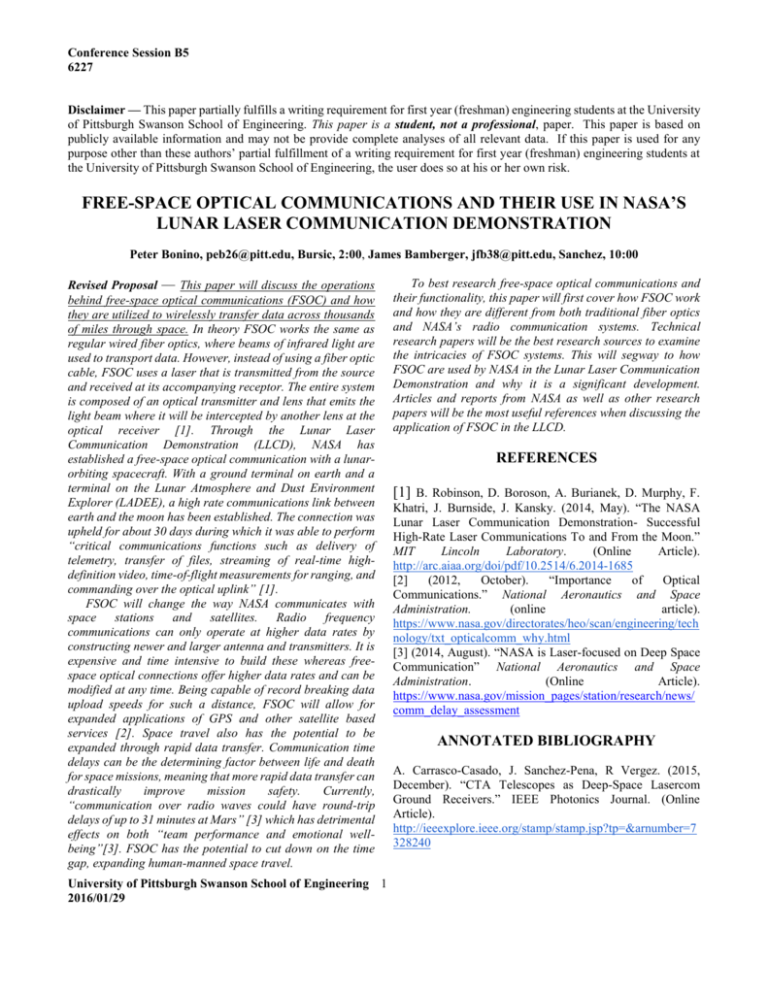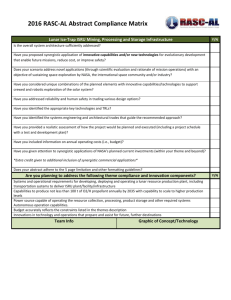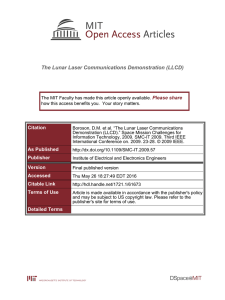Planar Lightwave Circuit Technology and its Application in Military
advertisement

Conference Session B5 6227 Disclaimer — This paper partially fulfills a writing requirement for first year (freshman) engineering students at the University of Pittsburgh Swanson School of Engineering. This paper is a student, not a professional, paper. This paper is based on publicly available information and may not be provide complete analyses of all relevant data. If this paper is used for any purpose other than these authors’ partial fulfillment of a writing requirement for first year (freshman) engineering students at the University of Pittsburgh Swanson School of Engineering, the user does so at his or her own risk. FREE-SPACE OPTICAL COMMUNICATIONS AND THEIR USE IN NASA’S LUNAR LASER COMMUNICATION DEMONSTRATION Peter Bonino, peb26@pitt.edu, Bursic, 2:00, James Bamberger, jfb38@pitt.edu, Sanchez, 10:00 Revised Proposal — This paper will discuss the operations behind free-space optical communications (FSOC) and how they are utilized to wirelessly transfer data across thousands of miles through space. In theory FSOC works the same as regular wired fiber optics, where beams of infrared light are used to transport data. However, instead of using a fiber optic cable, FSOC uses a laser that is transmitted from the source and received at its accompanying receptor. The entire system is composed of an optical transmitter and lens that emits the light beam where it will be intercepted by another lens at the optical receiver [1]. Through the Lunar Laser Communication Demonstration (LLCD), NASA has established a free-space optical communication with a lunarorbiting spacecraft. With a ground terminal on earth and a terminal on the Lunar Atmosphere and Dust Environment Explorer (LADEE), a high rate communications link between earth and the moon has been established. The connection was upheld for about 30 days during which it was able to perform “critical communications functions such as delivery of telemetry, transfer of files, streaming of real-time highdefinition video, time-of-flight measurements for ranging, and commanding over the optical uplink” [1]. FSOC will change the way NASA communicates with space stations and satellites. Radio frequency communications can only operate at higher data rates by constructing newer and larger antenna and transmitters. It is expensive and time intensive to build these whereas freespace optical connections offer higher data rates and can be modified at any time. Being capable of record breaking data upload speeds for such a distance, FSOC will allow for expanded applications of GPS and other satellite based services [2]. Space travel also has the potential to be expanded through rapid data transfer. Communication time delays can be the determining factor between life and death for space missions, meaning that more rapid data transfer can drastically improve mission safety. Currently, “communication over radio waves could have round-trip delays of up to 31 minutes at Mars” [3] which has detrimental effects on both “team performance and emotional wellbeing”[3]. FSOC has the potential to cut down on the time gap, expanding human-manned space travel. University of Pittsburgh Swanson School of Engineering 1 2016/01/29 To best research free-space optical communications and their functionality, this paper will first cover how FSOC work and how they are different from both traditional fiber optics and NASA’s radio communication systems. Technical research papers will be the best research sources to examine the intricacies of FSOC systems. This will segway to how FSOC are used by NASA in the Lunar Laser Communication Demonstration and why it is a significant development. Articles and reports from NASA as well as other research papers will be the most useful references when discussing the application of FSOC in the LLCD. REFERENCES [1] B. Robinson, D. Boroson, A. Burianek, D. Murphy, F. Khatri, J. Burnside, J. Kansky. (2014, May). “The NASA Lunar Laser Communication Demonstration- Successful High-Rate Laser Communications To and From the Moon.” MIT Lincoln Laboratory. (Online Article). http://arc.aiaa.org/doi/pdf/10.2514/6.2014-1685 [2] (2012, October). “Importance of Optical Communications.” National Aeronautics and Space Administration. (online article). https://www.nasa.gov/directorates/heo/scan/engineering/tech nology/txt_opticalcomm_why.html [3] (2014, August). “NASA is Laser-focused on Deep Space Communication” National Aeronautics and Space Administration. (Online Article). https://www.nasa.gov/mission_pages/station/research/news/ comm_delay_assessment ANNOTATED BIBLIOGRAPHY A. Carrasco-Casado, J. Sanchez-Pena, R Vergez. (2015, December). “CTA Telescopes as Deep-Space Lasercom Ground Receivers.” IEEE Photonics Journal. (Online Article). http://ieeexplore.ieee.org/stamp/stamp.jsp?tp=&arnumber=7 328240 Peter Bonino James Bamberger This article from a professional journal highlights the advantages that come with integrating free-space optical communications. Optical communication does not encounter the same restraints and limitations as radio frequency, and thus has become more prominent in recent years. We plan to use this journal article to describe the practicality of optical communications in space. Administration. (Online Article). https://www.nasa.gov/mission_pages/station/research/news/ comm_delay_assessment This is an article released by NASA that discusses how delays in communication between earth and manned spacecraft can cause issues and the initiatives being taken to improve the speed of connection. It contains valuable feedback from crew members that were on various space missions. This report is a more recent account of how NASA is using FSOC in the Optical Payload for Lasercomm Science (OPALS) investigation. “Deep Space Optical Communications (DSOC)”. National Aeronautics and Space Administration. (Online Article). http://gcd.larc.nasa.gov/projects/deep-space-opticalcommunications/#.VqjkfiorKM8 In this article NASA describes the Deep Space Optical Communication Project and states that the objective is to develop key technologies for the implementation of a deep space optical transceiver and ground receiver that will enable greater than 10X the data rate of a state-of-the-art deep space radio frequency system for similar spacecraft mass and power. This article provides us information on how optical communications is being implemented. “NSPE Code of Ethics for Engineers.” National Society of Professional Engineers. (Online Article). http://www.nspe.org/resources/ethics/code-ethics This is the official Code of Ethics for the National Society of Professional Engineers. It clearly outlines the expectations for engineers regarding honesty and integrity. It will be used to compare how FSOC aligns with the principles that engineers use to be professionals. Ethics are often thought as abstract principles but the NSPE makes them concrete and applicable in their code. (2012, October). “Importance of Optical Communications.” National Aeronautics and Space Administration. (online article). https://www.nasa.gov/directorates/heo/scan/engineering/tech nology/txt_opticalcomm_why.html This article from NASA explains its current issues with conventional methods of communication in space. In the past NASA has used radio frequency communications in order to communicate; however, with the complexity of missions increasing exponentially, these traditional methods are becoming less practical. In order to accommodate for the increase in data, NASA would have to significantly increase the size of its antennas or power of its radio transmitters. Optical communications offer a solution to this issue as they allow for more information to be sent faster with less antennas. We plan to use this source as a description of the limitations of radio frequency communications. B. Robinson, D. Boroson, A. Burianek, D. Murphy, F. Khatri, J. Burnside, J. Kansky. (2014). “The NASA Lunar Laser Communication Demonstration- Successful High-Rate Laser Communications To and From the Moon.” MIT Lincoln Laboratory. (Online Article). http://arc.aiaa.org/doi/pdf/10.2514/6.2014-1685 This article offers a technical explanation of the Lunar Laser Communication Demonstration that also highlights each major part of the project, that will help with our understanding of how the test was carried out. We will use this information in creating our explanation of how optical communications were developed and how they work. B. Robinson, D. Boroson, D. Burianek, D. Murphy. (2011). “The Lunar Laser Communications Demonstration.” MIT Lincoln Laboratory. (Online Article). http://ieeexplore.ieee.org/stamp/stamp.jsp?tp=&arnumber=5 783709 This journal article from the MIT Lincoln Laboratory describes NASA’s first attempt to demonstrate optical communications, which was named the Lunar Laser Communications Demonstration or LLCD. The LLCD’s goal was to successfully communicate from a lunar orbiting spacecraft to an Earth-based ground receiver. We plan to use this article to provide an explanation behind that technology that has allowed optical communication to come to fruition. “Lunar Laser Communications Demonstration (LLCD)”. (2014, May). National Aeronautics and Space Administration. (Online Article). https://www.nasa.gov/directorates/heo/scan/engineering/tech nology/txt_opticalcomm_start.html This article from NASA also describes the Lunar Laser Communications Demonstration and highlights the results from the project. Space Communications and Navigation, or SCaN, concluded as a result of this test that optical communication technology transferred data at much higher rates than radio frequency. Information from this article will aid our understanding of the LLCD project and the affect it will have on integrating optical communications in the future. (2014, August). “NASA is Laser-focused on Deep Space Communication” National Aeronautics and Space 2






